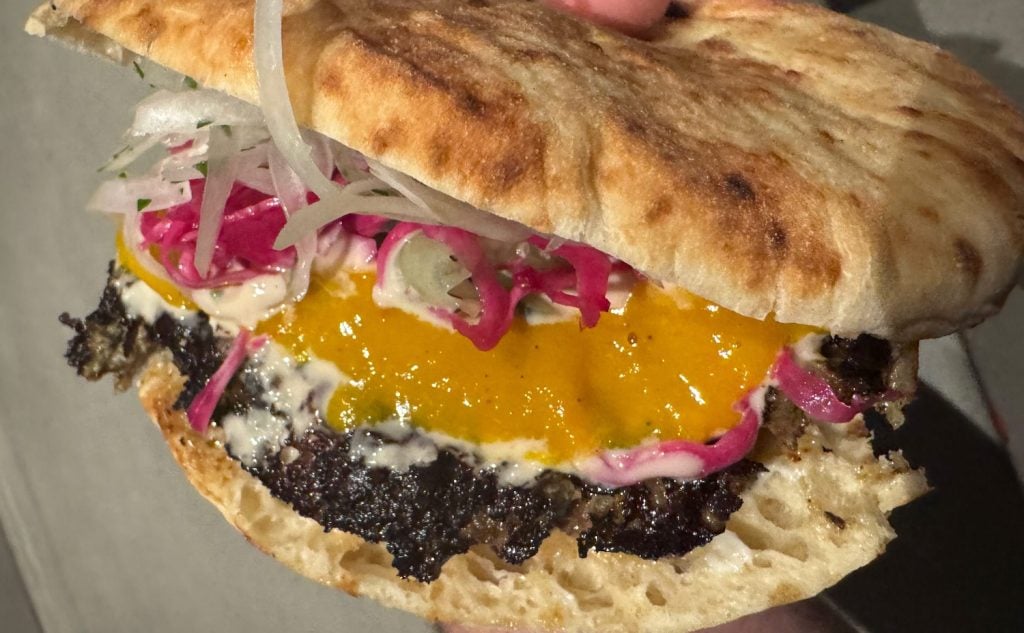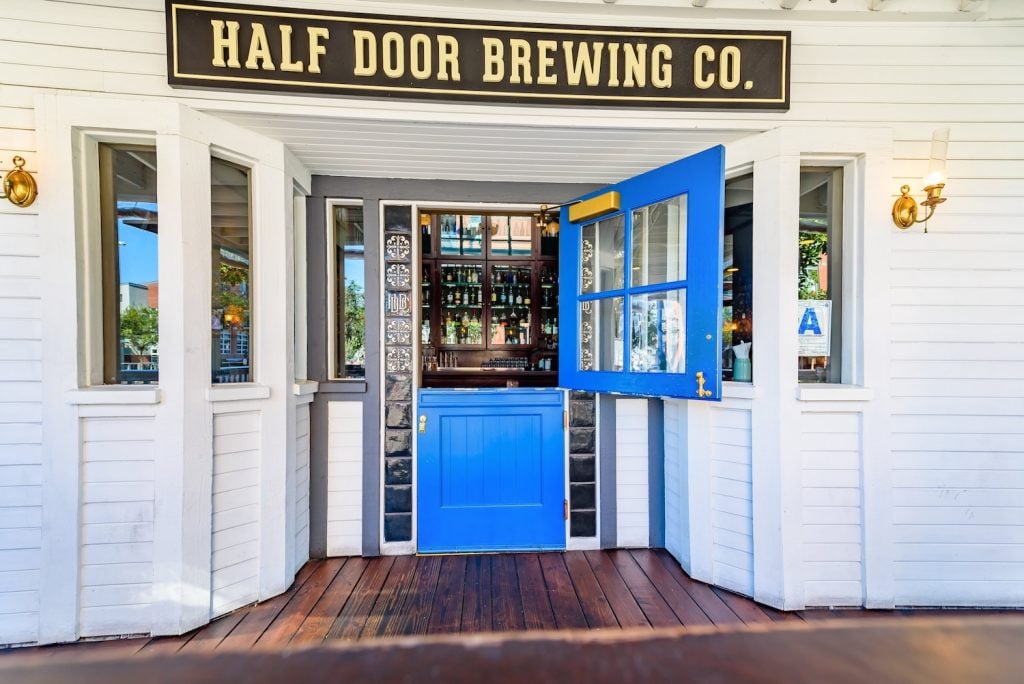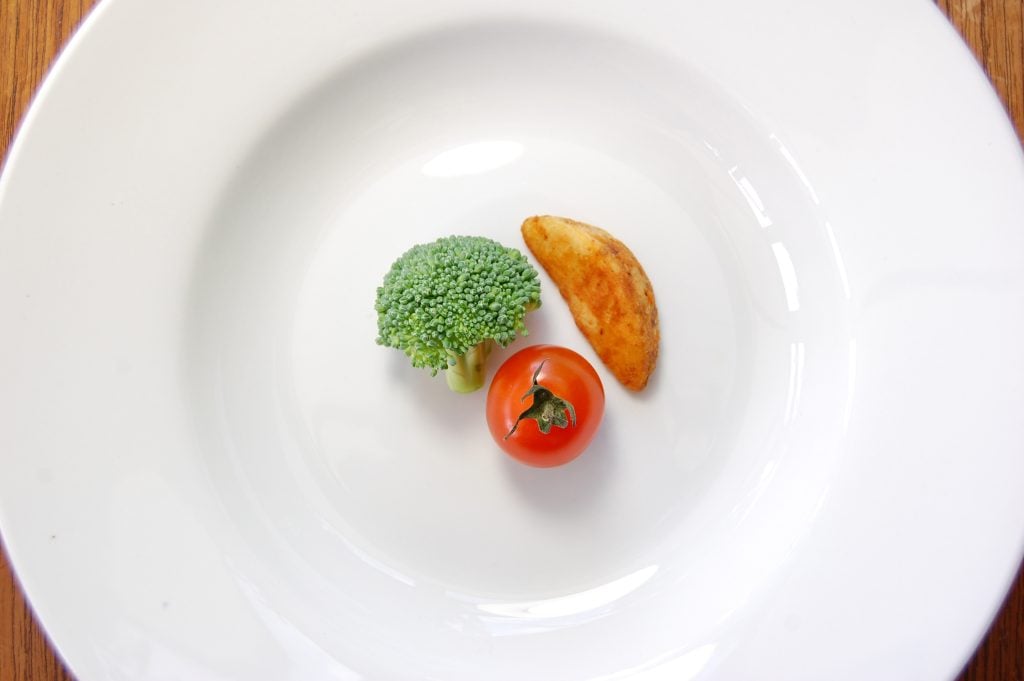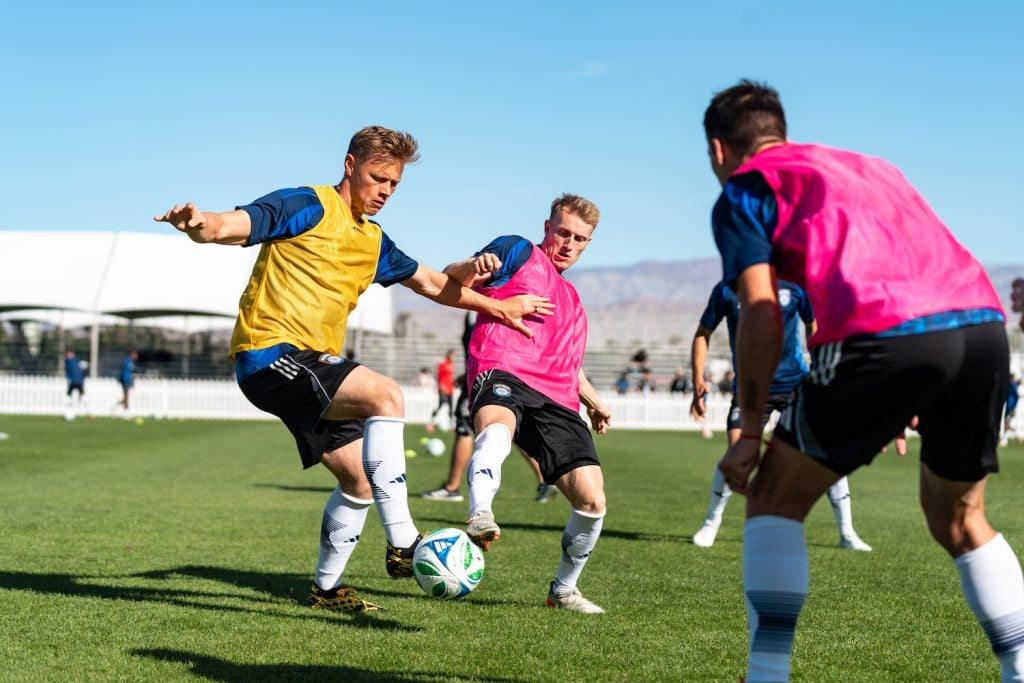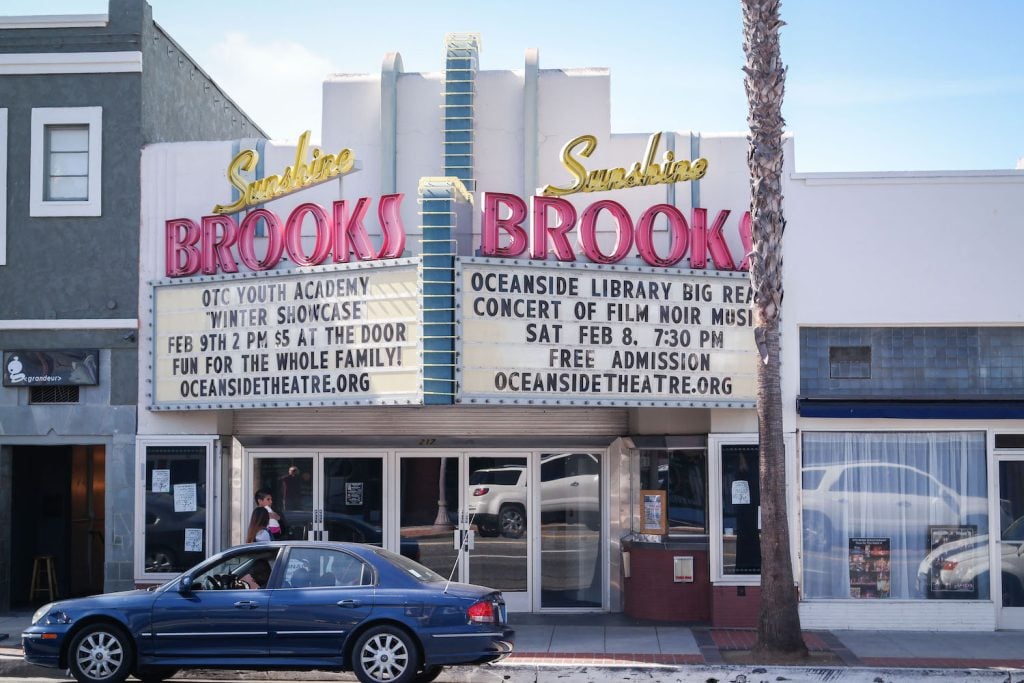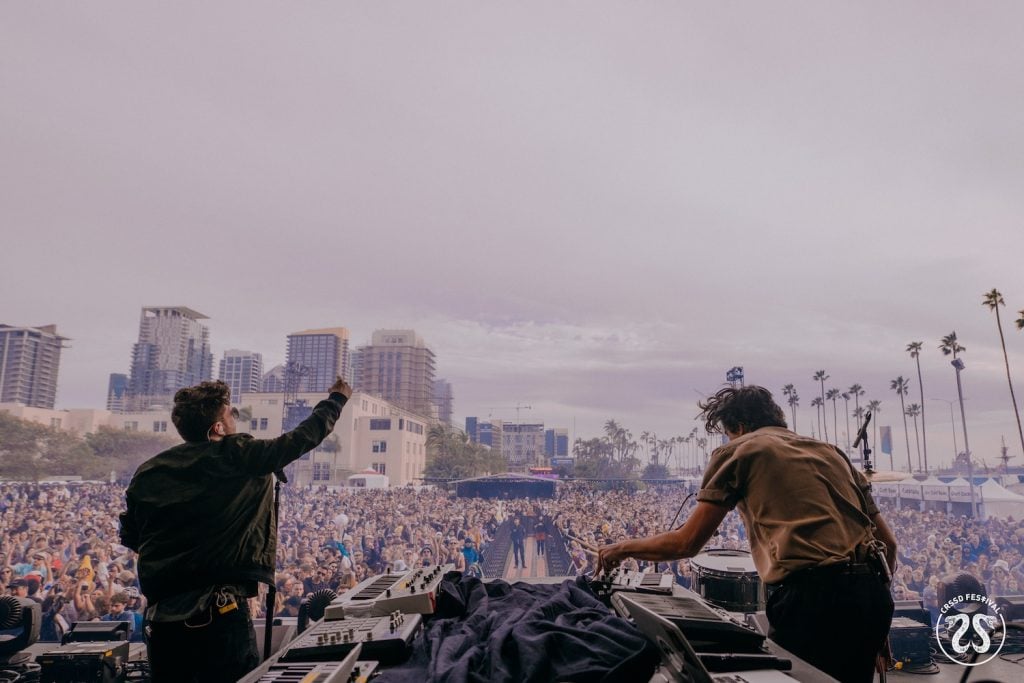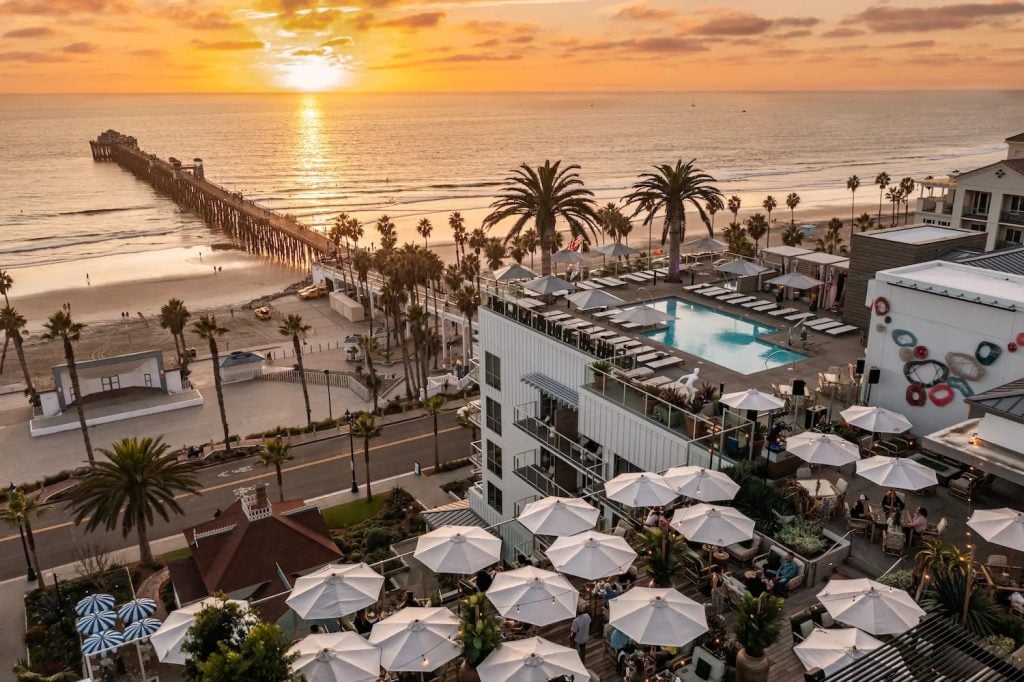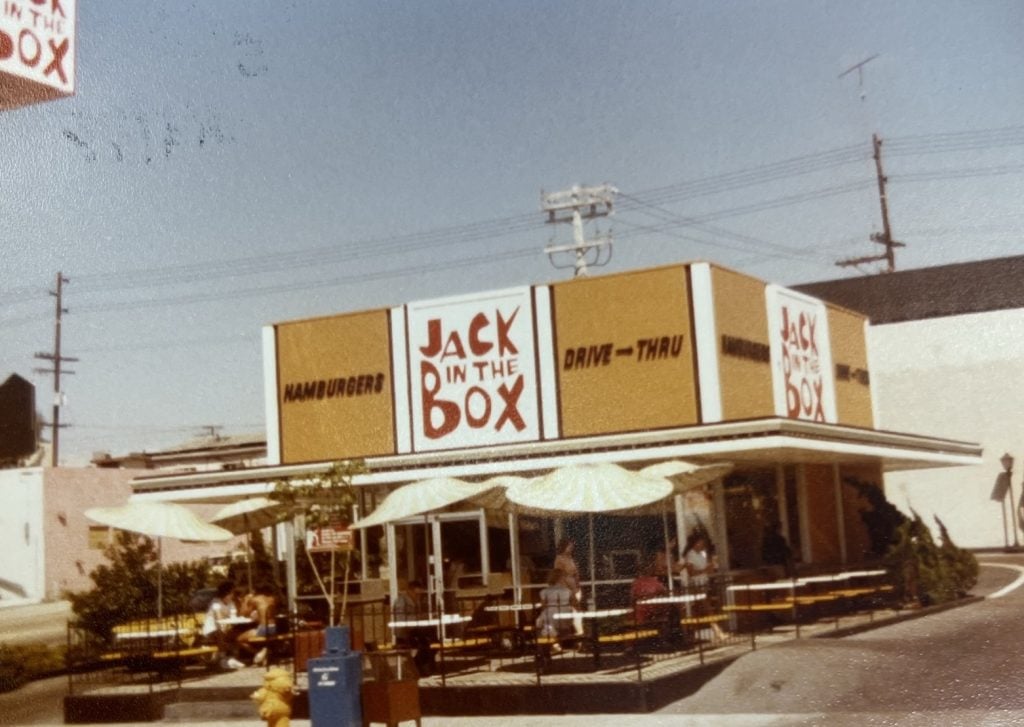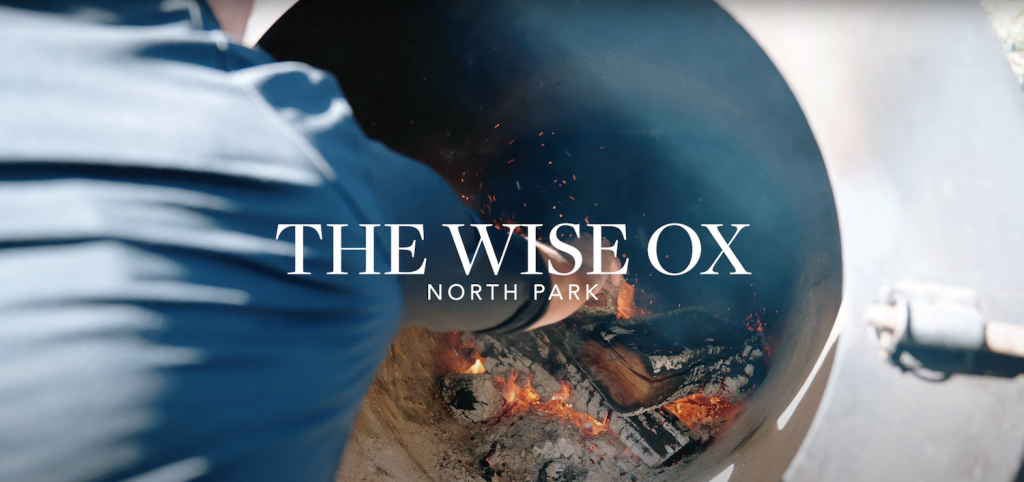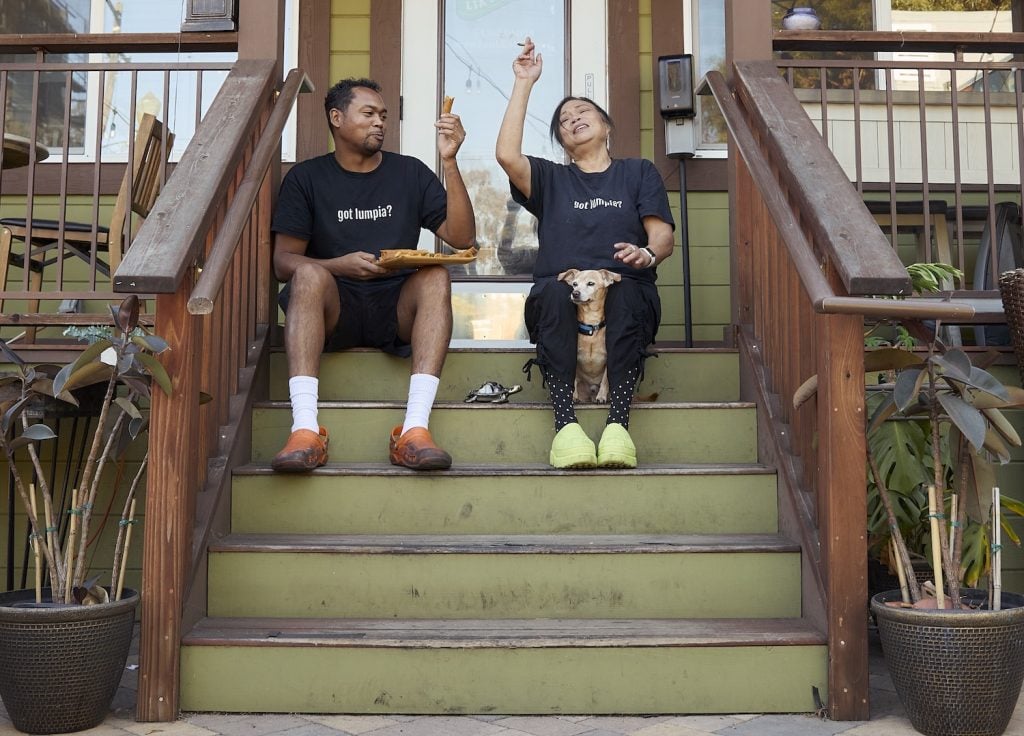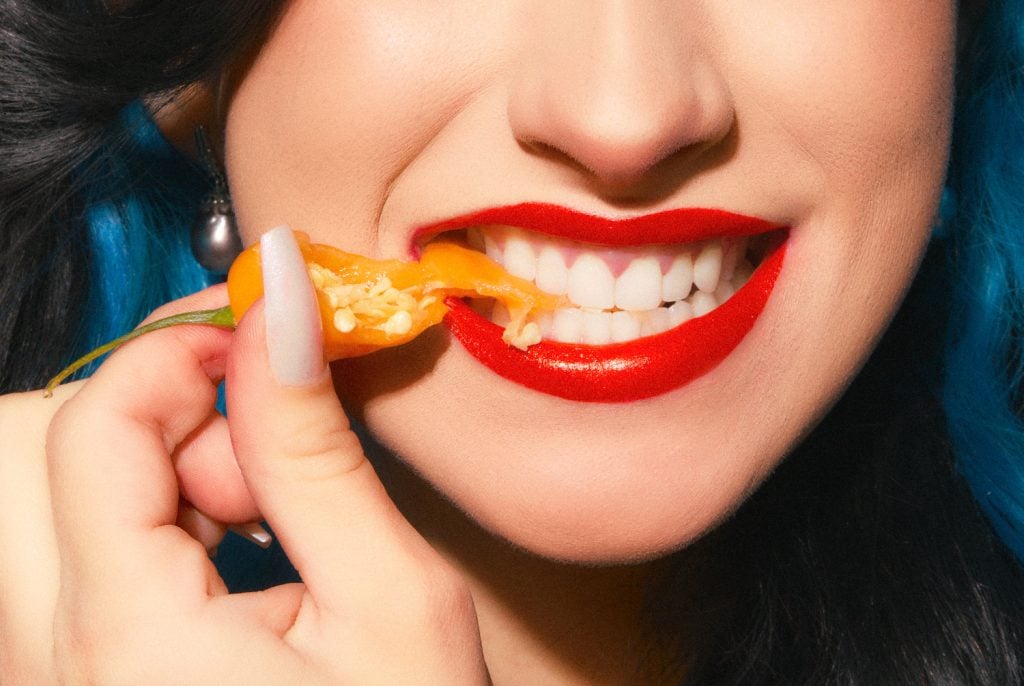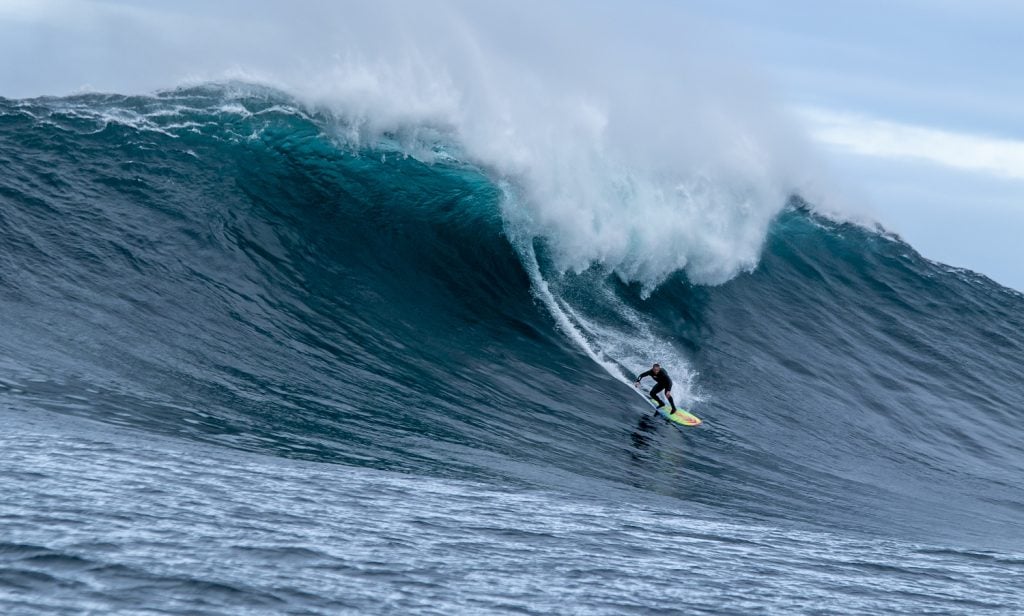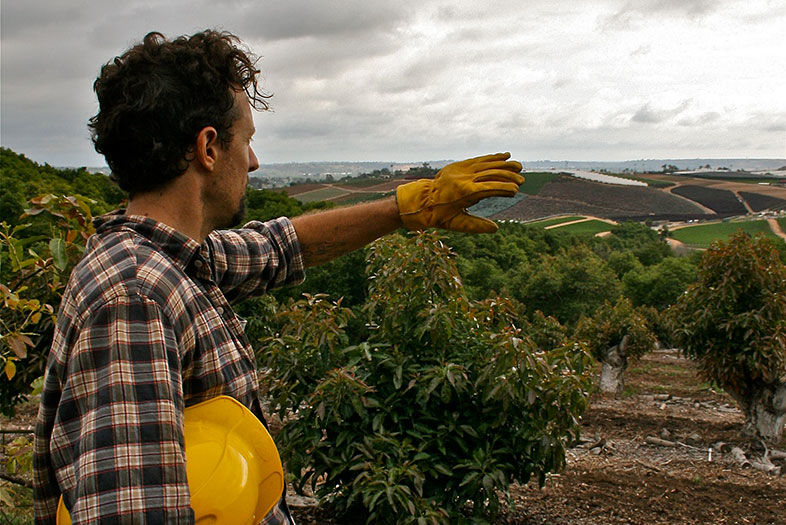The middle of nowhere is the best nowhere to be. After all the development in San Diego over the decades, it’s hard to believe a place like South Morro Hills exists. This is farmland. You’ve read about it in books. It’s east of downtown Oceanside, across the 5 Freeway, down some windy roads, a couple blocks past the moon.
Jason Mraz stands on a makeshift stage, guitar in hand, at the future site of what he hopes will be his and his wife’s “little coffee laboratory.” Following the lead of pioneering farmer Jay Ruskey, Mraz and a handful of others are growing the equatorial plant in Southern California.
He tells a story about his grandfather, a farmer. He sings a song about him, “Frank D. Fixer.” As a musician, Mraz has sold millions of records. It’s nice for community morale and cocktail party chat when a creative of his caliber makes his home in San Diego. It’s even nicer that he didn’t just buy a big plot of land and build a fortress.
Mraz is a farmer. For years, he’s been growing organic avocados near his Oceanside home. Now, with the help of a couple of top organic farmers, Jay Ruskey and Scott Murray, he’s nursing his baby coffee trees into fruition. Mraz also goes to city council meetings to help make sure San Diego farmers, and especially his neighbors in South Morro Hills, can survive. As SoCal’s recurring droughts jack up water prices, and labor costs climb, it’s getting difficult to make a living as a farmer. It’s getting harder to say no when housing developer after housing developer offer piles of money for your family’s farmland.
That’s why we’re all here on Mraz Family Farms for the first annual O’Side Feast. The City of Oceanside has dedicated money to explore agritourism. The idea is to make the area’s vast farmland a destination for locals and tourists, whether that’s for tastings at Beach House Winery, a tour of Cyclops Farms, or cuppings at Mraz’s eventual coffee lab in the country. Maybe there’ll be bed and breakfasts. Craft beer breweries. Micro distilleries. Mead breweries. Kombucha huts. Farm stands, cheese stands, creameries, apiaries (bee farms). Maybe one day Mraz will bring musician friends for a Farmchella.
The hope is that as Oceanside beaches and restaurants thrive, the farm country that delivers fresh food to their kitchens will do the same.
Who knows. They’re still mapping it out. Events like O’Side Feast are a start. A jovial toe dip into the unknown future of local farmers. The eventual hope is that as Oceanside beaches and restaurants thrive (the scene is booming), the farm country that delivers fresh food to their kitchens will do the same. That Oceanside, and San Diego, will see as much value in crops as they do condos.
On the drive up to Mraz Family Farms, there are so many avocado trees, waxy green herds of them. Looks like someone hit pause on a Morgan Freeman documentary film about their migration. The heat is venting an ancient, mean grudge. There’s no Big! Lots! and I can’t find a quality Applebees to save my life.
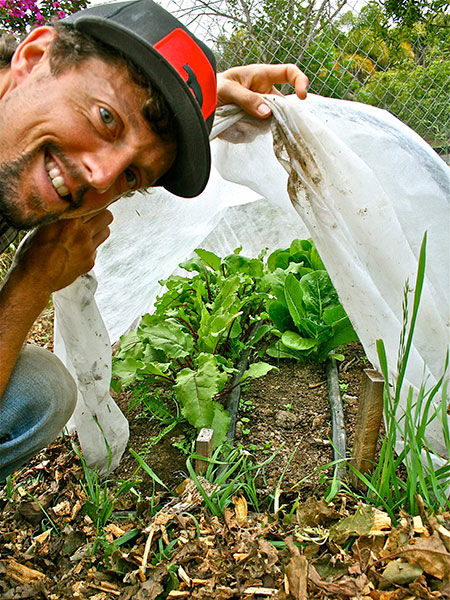
Jason Mraz Is Growing Coffee on a Farm in Oceanside
Photo: Louis Hayward
The event is lined by tents, and more avocado trees, where local food people worship shade and share what they made. Davin Waite from Oceanside’s Wrench & Rodent is here with his clean, righteous sushi. So is 608 chef-owner Willy Eick, who’s slicing hunks of fresh big-eye tuna loin, dipping it in white shoyu, and sprinkling some elderflower on top (“from that bush right there,” he says, pointing). Trailblazing bistro and pork whisperers The Flying Pig is there with trucker hats and, well, pork. Jan DeLyser shows me how to properly cut an avocado, and gives me a temporary avocado tattoo. Jan’s the vice president of marketing for California Avocado Commission, and San Diego County grows 40 percent of America’s avocados.
There’s an Oceanside company, Misadventure, that’s making vodka out of past-due baked goods that would otherwise go to waste. Golden Coast is serving tasters of their craft mead, the oldest alcohol in the world. Oceanside’s damn good Beach House Winery pours sips.
It’s all of Mraz’s neighbors, on an undeveloped hilltop that grows food, making a case for preserving hilltops that grow food.
He and I spoke about why food, why farming, why Oceanside, why coffee. A lot of whys. And a couple whats.
Why farming? Why food?
I guess it was probably somewhere between 2006 and 2009. It’s a little blurred. I saw the importance of healthy eating so that I could sustain myself on tour, not come home depleted and sick. I discovered the good food movement, and started to meet people into vegan, organic, slow food, different types of food narrative. And one of those narratives was farm-to-table and “eat your own zip code.” People were eating local because you could see the impact of food being shipped all around the world, and the negative effects on climate and carbon emissions.
I realized I live in an ag area. I’d lived in that region for five years, and I didn’t know anybody. I was kind of hiding there, or touring a lot. I held an event in 2009 or 2010, where I invited my whole neighborhood over to my house. I wanted to see who had a tractor, who was growing what, who’s composting, what can I learn from these neighbors before I commit to some big project and waste money and time. I got to meet a lot of people, and that’s only grown now.
What’s special about where you live?
It’s called South Morro Hills. It’s the western gate of Fallbrook. Many people, including myself, didn’t know it existed. Oceanside is the new Brooklyn of San Diego. Great restaurants, the best shops, still super low key and about surfers and makers, military families, and growers. Morro Hills is such a beautiful little island of green. When you drive on the 76 you can see it on the left, past the drive-in movie theater. And Oceanside could really benefit from saving this beautiful little island.
Oceanside is the new Brooklyn of San Diego.
Much like Luke Gerling’s farm, Cyclops, we could have more of those that could contribute to the restaurants, families, households of Oceanside. It’s a progressive, local community that sustains itself. Rather than importing things from all over the country or the world that we know puts pressure on the planet. It’s a gem of a resource.
This program that we’re doing is hopefully waking people up to this gem. And not just see it as more land to develop and more houses. I think there are other places we could put houses. There’s a great Rumi quote that the “earth turns to gold in the hands of the wise.”
Has Oceanside’s investment in agritourism helped?
The city’s been very gracious in helping and hearing us out. There’s only about 3,500 acres of remaining farmland. And if the land does get rezoned for high or medium density housing, it could become a domino effect. The large pieces of land could quickly turn into neighborhoods that save a couple acres for community gardens. We’ve just asked for a little more time to create a very comprehensive vision plan.
What do you and other farmers need?
What we need most are participants. There are only a handful of people who are creating farm businesses out here. There are commercial farmers, but they’ve never had a visitor setup. At Mellano Farm, you can go to Carlsbad and see their flower field; now that’s a proper visitor center.
Morro Hills isn’t really set up as a visitor center. What would help us is more young people interested in farming, be aggressive with whatever crop they’re interested in, whether it’s wine, coffee, guavas. One of the things that’s happening is the commercial farmer is retiring. The thing that looks best for their land is selling to a developer. What we need the most in my experience are participants. Young families who want to come out and start a farm business and use a small acreage of land to accommodate that.
You’re growing coffee. In California?
Scott Murray, my farming mentor, was the one who helped me eat my zip code right away when I moved here. He and his wife have a CSA program. I loved that. Scott helped me build my own garden, just a modest four rows with tomatoes and lettuce. Each year the garden grew and took shape and became my little hobby when I wasn’t making music.
In that narrative I said, “I want to convert these 40-year old avocados to organic.” I saw how expensive it was, and how commercial farming wasn’t profitable for my neighbors or myself. It required new laborers, new applications, certain transformations in terms of water runoff and whatever. My problem was I was a monoculture of avocados. I didn’t have enough diversity to pay back my water bill alone, with the rising water cost during the drought. I learned I needed to diversify.
Through the many different narratives, I asked, ‘What do chefs and people want? What is no one else growing that no one else can provide?’ We looked into saffron or artichokes or gooseberries. We put our feelers out there, and Scott came to us with this idea of coffee after hearing a lecture by Jay Ruskey of Good Land Organics. He said, if you can grow avocados, you can grow coffee.
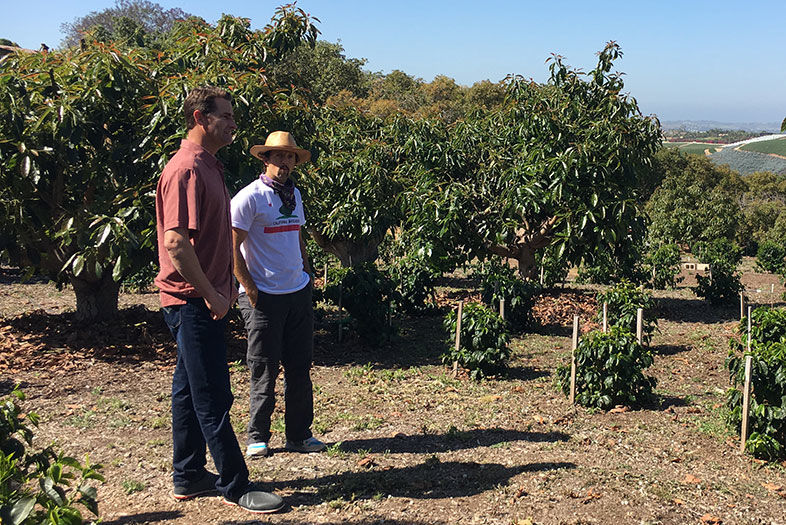
Jason Mraz Is Growing Coffee on a Farm in Oceanside
Mraz speaks with reporter Jeff Zevely | Photo by Shae Geary
Understand it’s a personal thing?
My wife and I just perked up, because I started my career in coffee shops, and I met my wife in a coffee shop. She used to own a coffee shop. Everywhere I tour, I just go into a corner and hide in coffee shops and take it all in. I love coffee shop culture. I love this idea of bringing coffee into our life. It’s a brand new industry for California. Maybe there are 20 or two dozen farmers, thanks to the research of Jay and Mark [Gaskell]. It’s a trial to be honest with you. We don’t know if it’s going to work or how productive it’s going to be.
When did you start planting?
They arrived in April of 2015, and the first ones went into the ground that October. We’ve had them in our care for over two years. The first six months were just us nursing them. Suddenly 2000 coffee trees show up at your door and shit gets real—real quick. We had to dig 2,300 holes, 2,300 chicken baskets to go around the trees, structures around each one so winter didn’t damage or blow them over. We had to make sure they weren’t sunburned. Scott helped me give great care to these trees. But it’s been a labor of love. The first ones are starting to show some beans. I think it adds to the unique experience of agritouriism paired with a rare crop to help save farmers.
Save farmers?
Around the world, coffee is grown by poor people. It’s not growing coffee that makes them poor. Growing coffee is a great opportunity for them to get out of a bad situation. Coffee is grown in landlocked regions, conflict regions, or regions bordering conflict. They’re just crushed right from the start.
Because coffee is the second hottest commodity on the planet, it’s this great opportunity for farmers to provide for their families. It’s showed up now in California at a time when farmers are facing failures, water costs, labor costs. After 1,500 years of people growing it around the world, I think it’s interesting that coffee as an opportunity shows up in California right now.
Almost as if the plant could feel us and it said, ‘Here you go.’ I love a good story. My music career gives an advantage as a farmer because I have a name. But I have to tell you my experience in farming has affected the way I write music.
Think California coffee can really be commercially viable?
Yes. I do. Specialty coffee, for specialty coffee enthusiasts. It’s for that market that’s willing to pay for a really good cup and story. I’ve paid 13 dollars for a cup of coffee. But it comes with the knowledge of the farmer, the flavor notes I’m looking for, the story of the land. I’m not just drinking a brilliant cup of coffee, I’m also drinking a story. And I think that’s what’s going to help our coffee but also our agricultural region.
What’s different about growing coffee in California, as opposed to the equatorial regions it’s usually grown in?
We have winter. And that slows down the maturation period in general. In 10 years, we’ll have beautiful flowers in the summer and hopefully they’ll be pollinated. It’ll take 10-12 months for that bean to fully ripen. In the equatorial regions, when you hear about shade grown coffee or high-altitude coffee, they have a similar effect—the slowing down of the maturation. And that can be a great thing. You’re giving that sugar in that cherry more time to influence the coffee bean. When it’s finally ready, you have more flavor potential. With the right roaster, you can bring up that flavor profile. Ruskey’s already had some great blind cuppings [blind taste tests by experts]. And his rate as some of the best in the world.
When could we see Mraz coffee in stores?
Well, I’m going to say 2020 or after. That’s when we should start to have a substantial amount of beans to play with. Some might show their flavor profile develops better after six or seven production runs. We have 11 different varieties, and each has different characteristics. This is not necessarily commodity coffee. What makes coffee possible in California is specialty coffee.
So maybe a Mraz coffee shop in Oceanside?
We’re holding O’Side Feast on what I hope is the future site of our own little coffee laboratory. It’s something we anticipate building in 2018 or 2019. It’ll be a sustainable structure that’ll be more of a flex space.
The footprint of the building is going to have to depend on what my zoning ordinance will allow, and that we haven’t figured out yet. It’s a collaboration with CalEarth. They help design and build sustainable structures that can last 500 years, as opposed to one where you’ve got to replace the roof in 50 years.
We not only want to inspire, but wow you when you see it. A lot of time it won’t be open to the public, where we’re drying coffee as well as avocados and various other tropical fruits. Maybe people will want to hold a wedding or a retreat there, bring in some chairs, get a sense of nature. It’s wild out here. I mean, everything is planted by man, but you still get a sense that you’re in the natural wild, which I love.
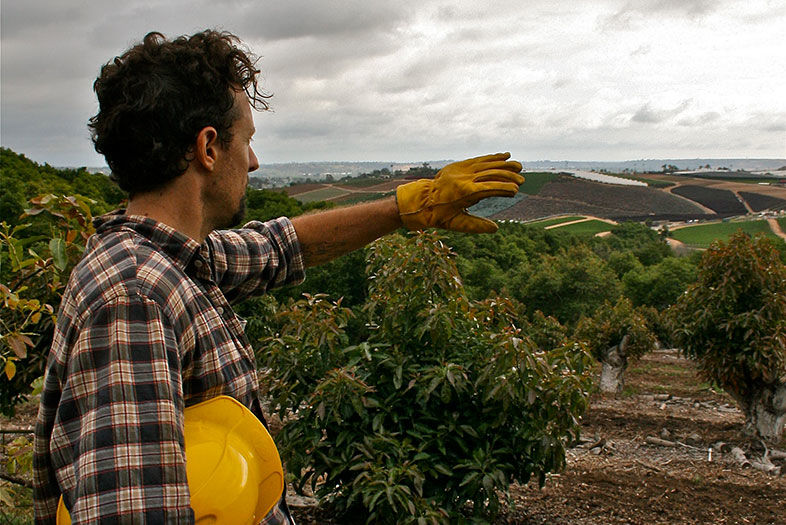
Jason Mraz Is Growing Coffee on a Farm in Oceanside
Jason Mraz overlooking the South Morro Hills. | Photo: Louis Hayward
